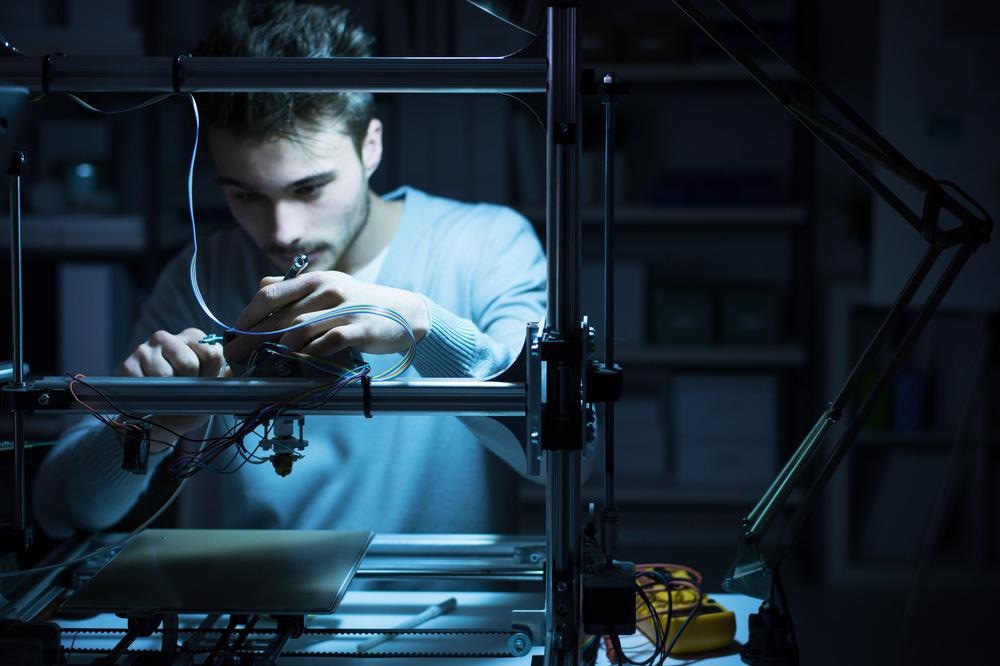Extruders are devices that heat and melt the feedstock and extrude it through the nozzle along a predetermined path on the print bed. Based on the material feeding, 3D printers are classified as filament extruders and pellet extruders. Most FDM printers use filament extruders, but studies have shown that pellet extruders in FDM demonstrate certain advantages over filament extruders.

Image Credit: Stock-Asso/Shutterstock.com
Three-dimensional (3D) printing, or additive manufacturing, is constructing a product from a computer-aided design model. Until 1980, the use of 3D printing was limited to prototyping, but its application has increased in recent years because of its advantages such as precision, reproducibility, and low production costs.
Standard 3D printing methods include fused filament fabrication (FFF), stereolithography (SLA), fused deposition modeling (FDM), material extrusion, binder jetting, powder jetting, and direct energy deposition.
Stratasys invented FDM printing in 1989, after which researchers and companies improved the technology for advanced applications and improved performance. The essential components of an FDM printer are a feeder, an extruder, and a nozzle. The procedure for FDM printing includes three steps: feeding the plastic filament into the extruder, melting the filament using the heated nozzle, and excursion of melted filament on a bed.
Filament- and Pellet-Based Extruders
Filament-based extruders (also known as hotheads) print materials by unwinding and heating plastic filament while the stepper motor regulates the filament delivery rate for the hothead. When the filament enters the nozzle, it melts upon reaching the glass transition temperature due to the heat generated by the nozzle. When the melted filament leaves the nozzles, it solidifies at ambient temperature. When the entire FDM printing procedure is conducted in an inert gas chamber, it prevents oxidation and improves the mechanical properties of the printed material.
The main advantages of filament extruders are high print quality, low oozing, ease of handling, and printing complex designs. The limitations of the filament extruders are wrapping of printed filament, clogging of the nozzle, and difficulty in adjusting the nozzle height with respect to the 3D printer bed.
Both pellet and filament extruders use a similar method to melt the polymer material (using a heating element) and solidify the polymer material post melting. The difference between pellet extruders and filament extruders is that pellet extruders use polymer granules instead of filament. Additionally, pellet extruders have components such as a hopper and an auger screw. Moreover, in pellet extruders, the screw supports pellet distribution from the inlet to the nozzle opening.
The molten plastic undergoes extreme pressure in pellet extruders, which is exerted by the screw's transport zone, melting zone, and mixing zone. Additionally, pellets are converted from solid to liquid paste by a heater that heats the screw and the barrel. Moreover, the motor attached to the screw rotates the screw, putting tremendous pressure on the extruded material, and the screw speed determines the exposure time of the pallet material.
The advantage of the pellet extruder over the filament extruder is that it reduces the cost of printing, as polylactic acid (PLA) pellets cost less than the PLA filament. Moreover, using a pallet extruder, users can print a wide range of materials and increase the speed of prints and recyclability of the 3D printing process. Commercial pellet extruders feature a minimum nozzle size and lightweight body suitable with a wide range of 3D printers.
The significant difficulties with the pellet extruder are warping, porosity, clogging, and uneven excursion. Wrapping describes a final product that has undesirable curves and bends. Porosity is the presence of voids and air bubbles inside or outside the finished print while clogging refers to the internal obstruction of an extruder that prevents the flow of molten plastic from the nozzle. The uneven excursion is the flow of molten plastic through a nozzle that is not uniform.
Recent Studies on Pellet Extruders
In a recent study published in the journal Polymers, researchers from Malaysia studied the recent developments in natural fiber-reinforced polymer components produced using additive manufacturing. The review demonstrated that pallet extrusion technology could produce natural fiber-reinforced polymers directly during the 3D printing process.
Additionally, recently researchers from South Korea 3D printed bio-based polycarbonate using the pallet extrusion process. The printed bio-based polycarbonate material showed superior tensile strength and improved sustainable characteristics to other commercial polymers.
Conclusion
Pellet extruders have enabled researchers and end-users to develop new filaments and materials. They support the development of new 3D printing concepts, improve sustainability in the 3D printing process, provide flexibility with material selection, and help develop new filaments.
References and Further Reading
Seong Je Park, Ji Eun Lee, Han Bit Lee, Jeanho Park, Nak-Kyu Lee, Yong Son, Suk-hee Park,3D printing of bio-based polycarbonate and its potential applications in eco-friendly indoor manufacturing, Additive Manufacturing, Volume 31,2020,100974, ISSN 2214-8604, https://www.sciencedirect.com/science/article/pii/S2214860419309285?via%3Dihub
Shaik, Y.P., Schuster, J. and Shaik, A. (2021) A Scientific Review on Various Pellet Extruders Used in 3D Printing FDM Processes. Open Access Library Journal, 8: e7698. https://doi.org/10.4236/oalib.1107698
Nurazzi, N.M.; Asyraf, M.R.M.; Khalina, A.; Abdullah, N.; Aisyah, H.A.; Rafiqah, S.A.; Sabaruddin, F.A.; Kamarudin, S.H.; Norrrahim, M.N.F.; Ilyas, R.A.; et al. A Review on Natural Fiber Reinforced Polymer Composite for Bullet Proof and Ballistic Applications. Polymers 2021, 13, 646. https://www.mdpi.com/2073-4360/13/4/646
Disclaimer: The views expressed here are those of the author expressed in their private capacity and do not necessarily represent the views of AZoM.com Limited T/A AZoNetwork the owner and operator of this website. This disclaimer forms part of the Terms and conditions of use of this website.